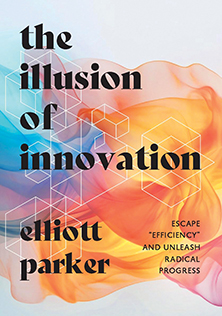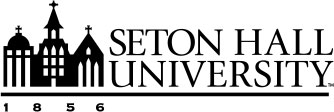
Embrace the Chaos
Friday, April 11, 2025
Why efficiency is the enemy of true innovation by breaking free from the constraints of short-term gains.

The Illusion of Innovation by Elliot Parker
Elliott Parker is a corporate consultant and founder of High Alpha Innovation. He built his career at Innosight, the firm funded by Clayton Christensen, author of the Innovators Dilemma. Parker is of the opinion that large organizations are uniquely suited to solving the significant problems of our day. However, they get trapped by the illusion of innovation because their focus is on efficiency. To create real innovation, corporations should focus on resiliency and harness "the power of small teams" to drive fundamental or radical changes through innovation by using small teams.
Parker advocates that the problems be delegated to small teams for the development of creative and new ideas, and that the small teams' systematic experimentation will drive radical change. Vesting the authority to propose radical change in small groups is akin to Eric Reis' notion of minimally viable product (MVP). Managers need to adjust to the messiness of innovation and let go of their exclusive focus on efficiency. There is a paradox here because a strategy of safety will lead to the failure of the company. Modern times require real innovation, and the illusion of innovation will lead to failure.
Parker's book, awarded an honorable mention by the Royal Dragonfly Book Award Contest in January, builds its themes on an important foundation stone – that learning and insights are valuable assets to a company. His analysis not only identifies what is conducive to learning and innovation but also alerts us to the inherent barriers to innovation, and impediments to transformative corporate research.
Parker's title, The Illusion of Innovation, is intended to call out the folly of an embedded, perhaps unconscious, corporate value system, where research and development can become calcified, limiting its focus to honing existing processes and operations. Success is defined as results that are quickly monetized. Experimental results that fail to monetize are penalized either explicitly in resource allocation and promotion policy, or implicitly through the imposition of return on invested capital (ROIC) or internal rate of return (IRR) metrics.
Whereas Edison's famous quote demonstrates his conviction that the knowledge of 10,000 things that don't work is indeed an asset, modern corporate accounting categorizes these as 10,000 mistakes, and the would-be innovators are not rewarded, but penalized for lack of results. Large-scale organizations have attained excellent results with tactics and operations honed and tweaked to achieve capital efficiency. But the nature of innovative discovery does not fit into this paradigm.
Reading Parker's indictment of corporate R & D myopia reminded me of the Austin Powers movie scene where Dr. Evil berates his staff, "You know I have one simple request, and that is to have sharks with laser beams attached to their heads! Remind me what I pay you people for." The boss is focused on expense and pre-conceived notions rather than embracing the chaos of innovation and creativity.
Parker argues that truly transformative innovations follow a power law pattern. Whereas most actionable improvement ideas are generated over a bell curve distribution of positive results, occurring within a reasonable number of experiments, (i.e., successes come relatively quickly). In contrast, a power law distribution has perhaps hundreds of zero-payback results. The hits occur only 1 percent to 2 percent of the time, but when they do occur, they yield extraordinarily high — even transformative — payoffs.
Parker draws a distinction between transformative innovations and others by categorizing innovations according to their relationship to existing operations:
- Performance-improving innovations such as replacing old products with new models. These merely keep the current customer dynamics in the current value proposition.
- Efficiency innovations — lowering operating costs. Again, these sustain or represent incremental improvement to the current paradigm.
- Empowering innovations — change radical enough to create new classes of customers and markets.
Typical financial metrics, intentionally or unintentionally, tend to prioritize the first two types of innovation at the expense of the third.
The Messy Nature of True Innovation
In his famous TED Talk, Sir Ken Robinson said, "If you're not prepared to be wrong, you'll never come up with anything original."1
Parker echoes this sentiment by urging us to shift our mindset. While he does not argue that being wrong is a good thing, he advocates processes that produce the most insights, furthers learning, maximizes potential for mutation, and uncovers anomalies. These processes are naturally messy and chaotic but produce collisions and novelty that can truly impact corporate resilience.
In order to shift our mindset, Parker provides some excellent guideposts to help break free from the bias toward capital efficiency and to encourage transformative thinking:
- Consider those engaged in experimentation as professional insight gatherers. The accumulation of insights is tantamount to gathering assets (a la Edison's quote).
- Experimentation is best done at the margins where failure is cheap but success can catch on.
- Empower small teams through decentralization.
- Encourage the pursuit of novelty in and of itself, regardless of the lack of apparent objective — again recognizing value in insights, regardless of the lack of obvious immediate application.
- Experiments should be designed to surface anomalies, to challenge — not reinforce — the status quo.
- Recognize that the traditional measures of positive results, such as capital returns, or employee production incentives may not work well due to the inherent uncertainty and longer-term payoff tail of the results.
- Recognize that experimentation is messy and chaotic — not hierarchical or objective driven.
- "Learn quickly through the accumulation of many small insights."2
Internal vs. External Launch
To avoid the inherent bias of corporate capital efficiency measures, Parker offers a useful decision metric for launching innovation operations internal to the company, or launching through investment in an external startup. He offers a quick heuristic:
"If you can build a forecast of first-year financial results for a new business concept with a high degree of confidence, you should likely launch the idea inside of a corporation. … When you're dealing primarily with a learning challenge, the new venture will have a much better chance of success if launched externally…" 3
| INTERNAL launch if the key to success is: |
EXTERNAL launch if the key to success is: |
| Close integration with the core existing operations | New model or customer base is different from (or even may compete with) the core |
| Internal expertise is more relevant and valuable | External expertise is more valuable |
| Moving at SCALE matters more | Moving FAST matters more |
| There are more knowns than unknowns – execution is more important | There are more unknowns – i.e., learning is more important than execution |
Reference4
Counterpoint – Parker Changes Direction
Having extolled the virtues of breaking free from the fetters of traditional capital efficiency dogma, Parker explores the prudence of building for long-term endurance.
"Enduring companies are very good at remembering what they've learned. …Companies that last centuries don't gamble with the resources. …Companies fail for one reason only: They run out of money. If you want your company to endure, don't run out of money." The world's most enduring institutions are hyper conservative about fiscal matters. Founders should make sure their companies are cheap to run and have a mission that attracts believers.
Where does the chaotic experimentation and gathering of insights of Parker's earlier counsel fit into this warning on long term fiscal conservation? To reconcile the seemingly opposing mandates of breaking free of the bonds of capital efficiency on the one hand, and paying heed to long term viability on the other, Parker advises this:
First, reinvent what can change — companies should have a clear sense of what must never change, but pursue reinventing everything else.
Second, obsess over customers for the long term. Base innovation by starting with the customers' needs and thinking backward, as opposed to thinking of what the company does well pushing forward, a "skills-forward" approach. ("We’re good at making hammers, let's find ways customers can pound things.")
Parker sums up the themes of his advice neatly:
“Those who change the world for the better build institutions that are mission oriented and optimized for long-term impact while finding new ways to serve the needs of their stakeholders. Again, it becomes clear that the secret to endurance is constant, rapid, and inexpensive experimentation in service of customer needs."5
In the Lead magazine is a collaboration between the Buccino Leadership Institute and the Stillman School of Business’s Department of Management. This edition reaffirms Seton Hall’s commitment to fostering innovative, ethical and impactful leadership. Stay ahead of the curve — explore the Spring 2025 issue of In the Lead.
1 Sir Ken Robinson, TED Talks, 2006, “Do Schools Kill Creativity.”
2 Page 97
3 Page 159
4 Page 161
5 Page 195
Categories: Business, Science and Technology

